National food of Kazakhstan
National food of Kazakhstan


#1 слайд
National food of
Kazakhstan
1 слайд
National food of Kazakhstan
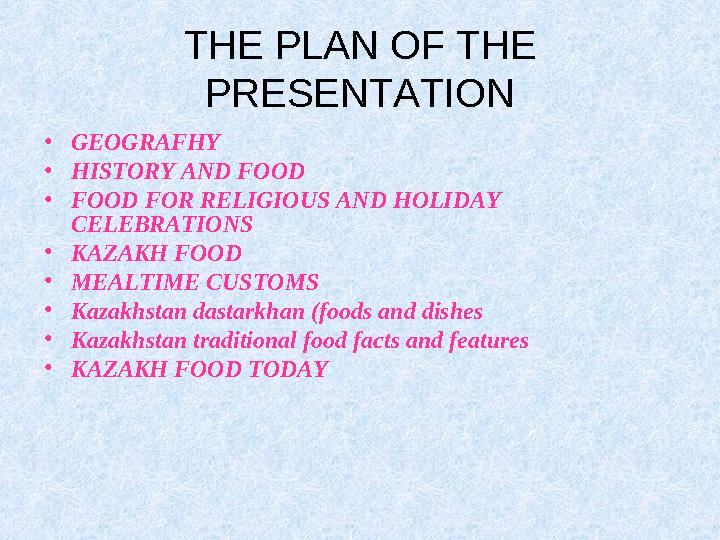
#2 слайд
THE PLAN OF THE
PRESENTATION
•GEOGRAFHY
•HISTORY AND FOOD
•FOOD FOR RELIGIOUS AND HOLIDAY
CELEBRATIONS
•KAZAKH FOOD
•MEALTIME CUSTOMS
•Kazakhstan dastarkhan (foods and dishes
•Kazakhstan traditional food facts and features
•KAZAKH FOOD TODAY
2 слайд
THE PLAN OF THE PRESENTATION •GEOGRAFHY •HISTORY AND FOOD •FOOD FOR RELIGIOUS AND HOLIDAY CELEBRATIONS •KAZAKH FOOD •MEALTIME CUSTOMS •Kazakhstan dastarkhan (foods and dishes •Kazakhstan traditional food facts and features •KAZAKH FOOD TODAY

#3 слайд
Kazakhstan is located in southern Asia between Russia and
Uzbekistan. Approximately 80 percent of the land consist of
lowlands, plains, and plateaus. Strong winds often sweep through
these flat lands. The country is about the size of two Alaskas—
around one million square miles. However, its population is only
about 17 million, less than New York City.
The climate in Kazakhstan is varied, and different plants and
animals are found according to region. Parts of Kazakhstan become
extremely cold in the winter and very hot during the summer. The
Kara Kum Desert, the world's fourth largest desert, occupies most of
central Kazakhstan.
Kazakhs constitute 46 percent of the population and Russians, 35
percent. The remaining population consists of Ukrainians, Germans,
Uzbeks, Tatar, and other groups.
1 GEOGRAPHIC SETTING AND ENVIRONMENT
3 слайд
Kazakhstan is located in southern Asia between Russia and Uzbekistan. Approximately 80 percent of the land consist of lowlands, plains, and plateaus. Strong winds often sweep through these flat lands. The country is about the size of two Alaskas— around one million square miles. However, its population is only about 17 million, less than New York City. The climate in Kazakhstan is varied, and different plants and animals are found according to region. Parts of Kazakhstan become extremely cold in the winter and very hot during the summer. The Kara Kum Desert, the world's fourth largest desert, occupies most of central Kazakhstan. Kazakhs constitute 46 percent of the population and Russians, 35 percent. The remaining population consists of Ukrainians, Germans, Uzbeks, Tatar, and other groups. 1 GEOGRAPHIC SETTING AND ENVIRONMENT
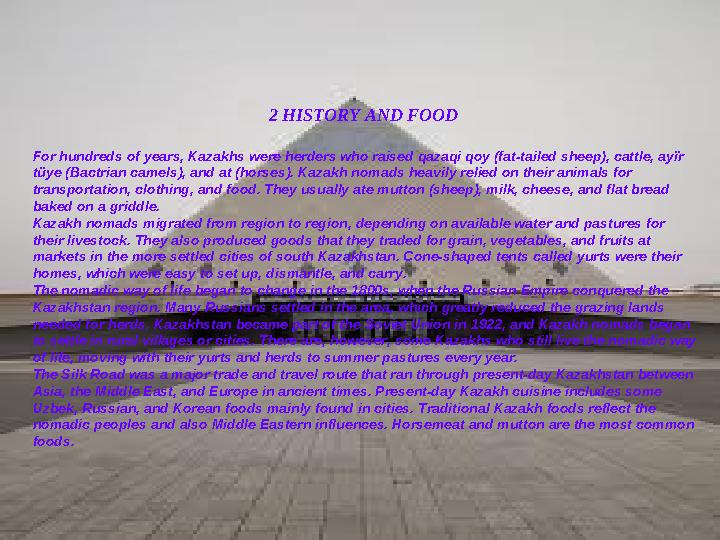
#4 слайд
2 HISTORY AND FOOD
For hundreds of years, Kazakhs were herders who raised qazaqi qoy (fat-tailed sheep), cattle, ayïr
tüye (Bactrian camels), and at (horses). Kazakh nomads heavily relied on their animals for
transportation, clothing, and food. They usually ate mutton (sheep), milk, cheese, and flat bread
baked on a griddle.
Kazakh nomads migrated from region to region, depending on available water and pastures for
their livestock. They also produced goods that they traded for grain, vegetables, and fruits at
markets in the more settled cities of south Kazakhstan. Cone-shaped tents called yurts were their
homes, which were easy to set up, dismantle, and carry.
The nomadic way of life began to change in the 1800s, when the Russian Empire conquered the
Kazakhstan region. Many Russians settled in the area, which greatly reduced the grazing lands
needed for herds. Kazakhstan became part of the Soviet Union in 1922, and Kazakh nomads began
to settle in rural villages or cities. There are, however, some Kazakhs who still live the nomadic way
of life, moving with their yurts and herds to summer pastures every year.
The Silk Road was a major trade and travel route that ran through present-day Kazakhstan between
Asia, the Middle East, and Europe in ancient times. Present-day Kazakh cuisine includes some
Uzbek, Russian, and Korean foods mainly found in cities. Traditional Kazakh foods reflect the
nomadic peoples and also Middle Eastern influences. Horsemeat and mutton are the most common
foods.
4 слайд
2 HISTORY AND FOOD For hundreds of years, Kazakhs were herders who raised qazaqi qoy (fat-tailed sheep), cattle, ayïr tüye (Bactrian camels), and at (horses). Kazakh nomads heavily relied on their animals for transportation, clothing, and food. They usually ate mutton (sheep), milk, cheese, and flat bread baked on a griddle. Kazakh nomads migrated from region to region, depending on available water and pastures for their livestock. They also produced goods that they traded for grain, vegetables, and fruits at markets in the more settled cities of south Kazakhstan. Cone-shaped tents called yurts were their homes, which were easy to set up, dismantle, and carry. The nomadic way of life began to change in the 1800s, when the Russian Empire conquered the Kazakhstan region. Many Russians settled in the area, which greatly reduced the grazing lands needed for herds. Kazakhstan became part of the Soviet Union in 1922, and Kazakh nomads began to settle in rural villages or cities. There are, however, some Kazakhs who still live the nomadic way of life, moving with their yurts and herds to summer pastures every year. The Silk Road was a major trade and travel route that ran through present-day Kazakhstan between Asia, the Middle East, and Europe in ancient times. Present-day Kazakh cuisine includes some Uzbek, Russian, and Korean foods mainly found in cities. Traditional Kazakh foods reflect the nomadic peoples and also Middle Eastern influences. Horsemeat and mutton are the most common foods.

#5 слайд
3 FOODS OF THE KAZAKHS
Based on nomadic roots, horse meat and mutton (meat
from sheep) are the basis of a majority of Kazakh dishes.
Dishes include shuzhuk (a type of sausage made from
smoked horse meat), and kuyrdak . Kuyrdak (also
spelled kuirdak) is prepared from a freshly slaughtered
horse, sheep, or cow, and consists of the animal's heart,
liver, kidneys, and other organs. They are cut into
pieces, boiled in oil, and served with onion and pepper.
Basturma is mutton eaten with fresh cucumbers and
tomatoes. Round, flat loaves of bread accompany most
meals.
5 слайд
3 FOODS OF THE KAZAKHS Based on nomadic roots, horse meat and mutton (meat from sheep) are the basis of a majority of Kazakh dishes. Dishes include shuzhuk (a type of sausage made from smoked horse meat), and kuyrdak . Kuyrdak (also spelled kuirdak) is prepared from a freshly slaughtered horse, sheep, or cow, and consists of the animal's heart, liver, kidneys, and other organs. They are cut into pieces, boiled in oil, and served with onion and pepper. Basturma is mutton eaten with fresh cucumbers and tomatoes. Round, flat loaves of bread accompany most meals.
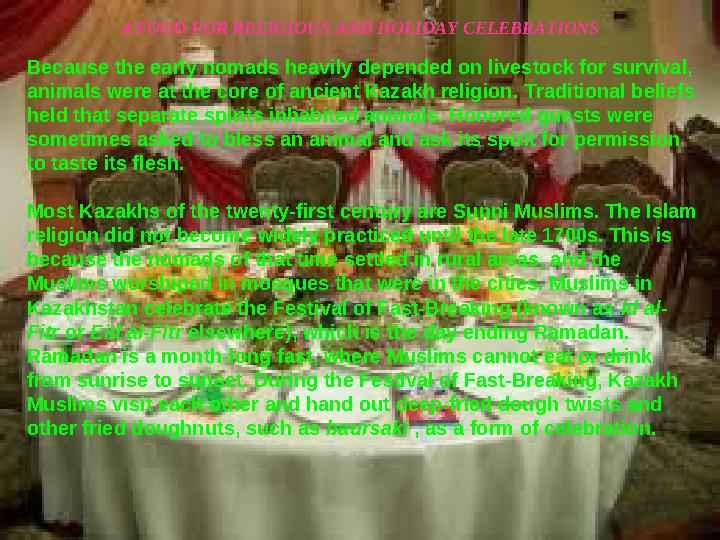
#6 слайд
4 FOOD FOR RELIGIOUS AND HOLIDAY CELEBRATIONS
Because the early nomads heavily depended on livestock for survival,
animals were at the core of ancient Kazakh religion. Traditional beliefs
held that separate spirits inhabited animals. Honored guests were
sometimes asked to bless an animal and ask its spirit for permission
to taste its flesh.
Most Kazakhs of the twenty-first century are Sunni Muslims. The Islam
religion did not become widely practiced until the late 1700s. This is
because the nomads of that time settled in rural areas, and the
Muslims worshiped in mosques that were in the cities. Muslims in
Kazakhstan celebrate the Festival of Fast-Breaking (known as Id al-
Fitr or Eid al-Fitr elsewhere), which is the day ending Ramadan.
Ramadan is a month-long fast, where Muslims cannot eat or drink
from sunrise to sunset. During the Festival of Fast-Breaking, Kazakh
Muslims visit each other and hand out deep-fried dough twists and
other fried doughnuts, such as baursaki , as a form of celebration.
6 слайд
4 FOOD FOR RELIGIOUS AND HOLIDAY CELEBRATIONS Because the early nomads heavily depended on livestock for survival, animals were at the core of ancient Kazakh religion. Traditional beliefs held that separate spirits inhabited animals. Honored guests were sometimes asked to bless an animal and ask its spirit for permission to taste its flesh. Most Kazakhs of the twenty-first century are Sunni Muslims. The Islam religion did not become widely practiced until the late 1700s. This is because the nomads of that time settled in rural areas, and the Muslims worshiped in mosques that were in the cities. Muslims in Kazakhstan celebrate the Festival of Fast-Breaking (known as Id al- Fitr or Eid al-Fitr elsewhere), which is the day ending Ramadan. Ramadan is a month-long fast, where Muslims cannot eat or drink from sunrise to sunset. During the Festival of Fast-Breaking, Kazakh Muslims visit each other and hand out deep-fried dough twists and other fried doughnuts, such as baursaki , as a form of celebration.
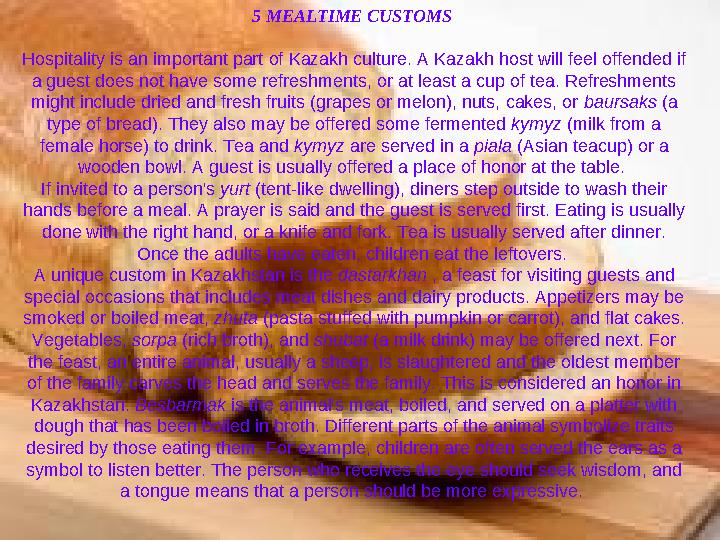
#7 слайд
5 MEALTIME CUSTOMS
Hospitality is an important part of Kazakh culture. A Kazakh host will feel offended if
a guest does not have some refreshments, or at least a cup of tea. Refreshments
might include dried and fresh fruits (grapes or melon), nuts, cakes, or baursaks (a
type of bread). They also may be offered some fermented kymyz (milk from a
female horse) to drink. Tea and kymyz are served in a piala (Asian teacup) or a
wooden bowl. A guest is usually offered a place of honor at the table.
If invited to a person's yurt (tent-like dwelling), diners step outside to wash their
hands before a meal. A prayer is said and the guest is served first. Eating is usually
done with the right hand, or a knife and fork. Tea is usually served after dinner.
Once the adults have eaten, children eat the leftovers.
A unique custom in Kazakhstan is the dastarkhan , a feast for visiting guests and
special occasions that includes meat dishes and dairy products. Appetizers may be
smoked or boiled meat, zhuta (pasta stuffed with pumpkin or carrot), and flat cakes.
Vegetables, sorpa (rich broth), and shubat (a milk drink) may be offered next. For
the feast, an entire animal, usually a sheep, is slaughtered and the oldest member
of the family carves the head and serves the family. This is considered an honor in
Kazakhstan. Besbarmak is the animal's meat, boiled, and served on a platter with
dough that has been boiled in broth. Different parts of the animal symbolize traits
desired by those eating them. For example, children are often served the ears as a
symbol to listen better. The person who receives the eye should seek wisdom, and
a tongue means that a person should be more expressive.
7 слайд
5 MEALTIME CUSTOMS Hospitality is an important part of Kazakh culture. A Kazakh host will feel offended if a guest does not have some refreshments, or at least a cup of tea. Refreshments might include dried and fresh fruits (grapes or melon), nuts, cakes, or baursaks (a type of bread). They also may be offered some fermented kymyz (milk from a female horse) to drink. Tea and kymyz are served in a piala (Asian teacup) or a wooden bowl. A guest is usually offered a place of honor at the table. If invited to a person's yurt (tent-like dwelling), diners step outside to wash their hands before a meal. A prayer is said and the guest is served first. Eating is usually done with the right hand, or a knife and fork. Tea is usually served after dinner. Once the adults have eaten, children eat the leftovers. A unique custom in Kazakhstan is the dastarkhan , a feast for visiting guests and special occasions that includes meat dishes and dairy products. Appetizers may be smoked or boiled meat, zhuta (pasta stuffed with pumpkin or carrot), and flat cakes. Vegetables, sorpa (rich broth), and shubat (a milk drink) may be offered next. For the feast, an entire animal, usually a sheep, is slaughtered and the oldest member of the family carves the head and serves the family. This is considered an honor in Kazakhstan. Besbarmak is the animal's meat, boiled, and served on a platter with dough that has been boiled in broth. Different parts of the animal symbolize traits desired by those eating them. For example, children are often served the ears as a symbol to listen better. The person who receives the eye should seek wisdom, and a tongue means that a person should be more expressive.
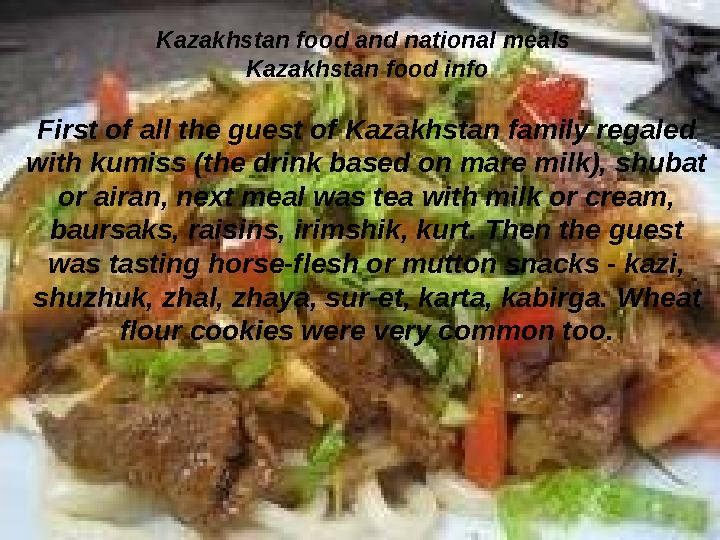
#8 слайд
Kazakhstan food and national meals
Kazakhstan food info
First of all the guest of Kazakhstan family regaled
with kumiss (the drink based on mare milk), shubat
or airan, next meal was tea with milk or cream,
baursaks, raisins, irimshik, kurt. Then the guest
was tasting horse-flesh or mutton snacks - kazi,
shuzhuk, zhal, zhaya, sur-et, karta, kabirga. Wheat
flour cookies were very common too.
8 слайд
Kazakhstan food and national meals Kazakhstan food info First of all the guest of Kazakhstan family regaled with kumiss (the drink based on mare milk), shubat or airan, next meal was tea with milk or cream, baursaks, raisins, irimshik, kurt. Then the guest was tasting horse-flesh or mutton snacks - kazi, shuzhuk, zhal, zhaya, sur-et, karta, kabirga. Wheat flour cookies were very common too.
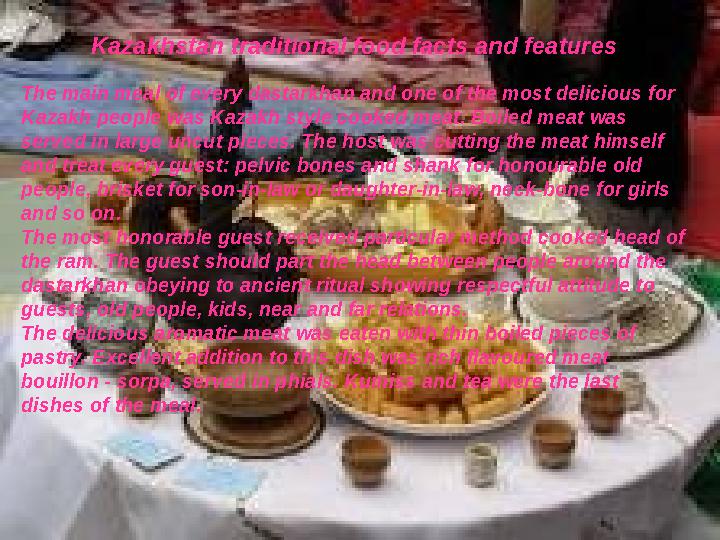
#9 слайд
Kazakhstan traditional food facts and features
The main meal of every dastarkhan and one of the most delicious for
Kazakh people was Kazakh style cooked meat. Boiled meat was
served in large uncut pieces. The host was cutting the meat himself
and treat every guest: pelvic bones and shank for honourable old
people, brisket for son-in-law or daughter-in-law, neck-bone for girls
and so on.
The most honorable guest received particular method cooked head of
the ram. The guest should part the head between people around the
dastarkhan obeying to ancient ritual showing respectful attitude to
guests, old people, kids, near and far relations.
The delicious aromatic meat was eaten with thin boiled pieces of
pastry. Excellent addition to this dish was rich flavoured meat
bouillon - sorpa, served in phials. Kumiss and tea were the last
dishes of the meal.
9 слайд
Kazakhstan traditional food facts and features The main meal of every dastarkhan and one of the most delicious for Kazakh people was Kazakh style cooked meat. Boiled meat was served in large uncut pieces. The host was cutting the meat himself and treat every guest: pelvic bones and shank for honourable old people, brisket for son-in-law or daughter-in-law, neck-bone for girls and so on. The most honorable guest received particular method cooked head of the ram. The guest should part the head between people around the dastarkhan obeying to ancient ritual showing respectful attitude to guests, old people, kids, near and far relations. The delicious aromatic meat was eaten with thin boiled pieces of pastry. Excellent addition to this dish was rich flavoured meat bouillon - sorpa, served in phials. Kumiss and tea were the last dishes of the meal.

#10 слайд
Kazakhstan dastarkhan (foods and dishes)
Mostly Kazakhstan food is made from meat and milk, above all, delicacies made from horse meat
such as
* shuzhuk (sausage made of finely chopped meat);
* kazy (sausage from ribs);
* karta (sausage from the belly);
* zhaya (boiled rump);
* zhal (from urthers);
* steaming kuirdak (from freshly killed sheep);
* zhaubuirek (a whole carcass of a ram broiled on a spit);
* syrbaz (a suckling lamb stewed in its own juice);
* srneh (a whole deep-fried year-old lamb);
* burmeh (a whole carcass of a ram stewed in its own skin in a hole dug in the earth with
a fire made on top of it);
* beshbarmak (a dressed carcass of a ram or a foal boiled in a cauldron).
In a word, you will be treated to every gourmet specialty that Kazakhstan cuisine has to offer.
Of course, the dastarkhan is a serious test of the hostess’ culinary talents. At the same time it
is also an expression of the host’s cordiality and generosity. Often everyone in the neighborhood
who is noted for eloquence, singing or playing musical instruments is invited to such dinners.
“Why such a feast?” you may ask.
There are many Kazakhstan sayings that may serve as an answer to this question: “You will
never forget those with whom you once had a heart-to-heart talk at a good dastarkhan”; “You must
send your best wishes to those whom you once entertained in your home to the end of your life”.
Kazakhstan dastarkhan not only satisfies your thirst and hunger, it also lifts up your spirit.
People learn much about one another at a dastarkhan. And the word “hospitality” means not only
a heart meal accompanied by merrymaking and laughter: it means above all a cordial conversation
with the guest.
10 слайд
Kazakhstan dastarkhan (foods and dishes) Mostly Kazakhstan food is made from meat and milk, above all, delicacies made from horse meat such as * shuzhuk (sausage made of finely chopped meat); * kazy (sausage from ribs); * karta (sausage from the belly); * zhaya (boiled rump); * zhal (from urthers); * steaming kuirdak (from freshly killed sheep); * zhaubuirek (a whole carcass of a ram broiled on a spit); * syrbaz (a suckling lamb stewed in its own juice); * srneh (a whole deep-fried year-old lamb); * burmeh (a whole carcass of a ram stewed in its own skin in a hole dug in the earth with a fire made on top of it); * beshbarmak (a dressed carcass of a ram or a foal boiled in a cauldron). In a word, you will be treated to every gourmet specialty that Kazakhstan cuisine has to offer. Of course, the dastarkhan is a serious test of the hostess’ culinary talents. At the same time it is also an expression of the host’s cordiality and generosity. Often everyone in the neighborhood who is noted for eloquence, singing or playing musical instruments is invited to such dinners. “Why such a feast?” you may ask. There are many Kazakhstan sayings that may serve as an answer to this question: “You will never forget those with whom you once had a heart-to-heart talk at a good dastarkhan”; “You must send your best wishes to those whom you once entertained in your home to the end of your life”. Kazakhstan dastarkhan not only satisfies your thirst and hunger, it also lifts up your spirit. People learn much about one another at a dastarkhan. And the word “hospitality” means not only a heart meal accompanied by merrymaking and laughter: it means above all a cordial conversation with the guest.

#11 слайд
Beshbarmak , a traditional dish of meat (such as mutton) is
eaten with boiled dough. The dough is rolled into thin strips and cooked
in mutton broth. It is served with mutton over the top and flavored with
garlic and onions. Qazy is smoked horsemeat sausage, sometimes
served sliced over cold noodles.
11 слайд
Beshbarmak , a traditional dish of meat (such as mutton) is eaten with boiled dough. The dough is rolled into thin strips and cooked in mutton broth. It is served with mutton over the top and flavored with garlic and onions. Qazy is smoked horsemeat sausage, sometimes served sliced over cold noodles.
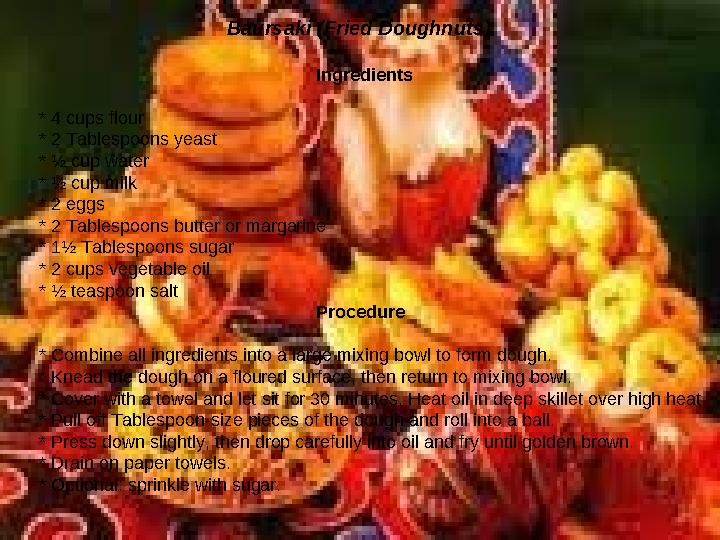
#12 слайд
Baursaki (Fried Doughnuts)
Ingredients
* 4 cups flour
* 2 Tablespoons yeast
* ½ cup water
* ½ cup milk
* 2 eggs
* 2 Tablespoons butter or margarine
* 1½ Tablespoons sugar
* 2 cups vegetable oil
* ½ teaspoon salt
Procedure
* Combine all ingredients into a large mixing bowl to form dough.
* Knead the dough on a floured surface, then return to mixing bowl.
* Cover with a towel and let sit for 30 minutes. Heat oil in deep skillet over high heat.
* Pull off Tablespoon-size pieces of the dough and roll into a ball.
* Press down slightly, then drop carefully into oil and fry until golden brown.
* Drain on paper towels.
* Optional: sprinkle with sugar.
12 слайд
Baursaki (Fried Doughnuts) Ingredients * 4 cups flour * 2 Tablespoons yeast * ½ cup water * ½ cup milk * 2 eggs * 2 Tablespoons butter or margarine * 1½ Tablespoons sugar * 2 cups vegetable oil * ½ teaspoon salt Procedure * Combine all ingredients into a large mixing bowl to form dough. * Knead the dough on a floured surface, then return to mixing bowl. * Cover with a towel and let sit for 30 minutes. Heat oil in deep skillet over high heat. * Pull off Tablespoon-size pieces of the dough and roll into a ball. * Press down slightly, then drop carefully into oil and fry until golden brown. * Drain on paper towels. * Optional: sprinkle with sugar.

#13 слайд
Drop balls of dough into hot oil. Then sprinkle the finished baursaki with sugar.
13 слайд
Drop balls of dough into hot oil. Then sprinkle the finished baursaki with sugar.

#14 слайд
Secular (non-religious) holidays include International Women's Day (March 8)
and New Year's Day. On March 8, all women (not just mothers) are honored and
celebrated by food and dancing. New Year's
Nomadic women prepare bread to be baked on a griddle over an open fire.
Day is celebrated much like Christmas in the United States. People decorate
trees in their homes, exchange gifts, and gather with family and friends to sing
and eat together.
14 слайд
Secular (non-religious) holidays include International Women's Day (March 8) and New Year's Day. On March 8, all women (not just mothers) are honored and celebrated by food and dancing. New Year's Nomadic women prepare bread to be baked on a griddle over an open fire. Day is celebrated much like Christmas in the United States. People decorate trees in their homes, exchange gifts, and gather with family and friends to sing and eat together.
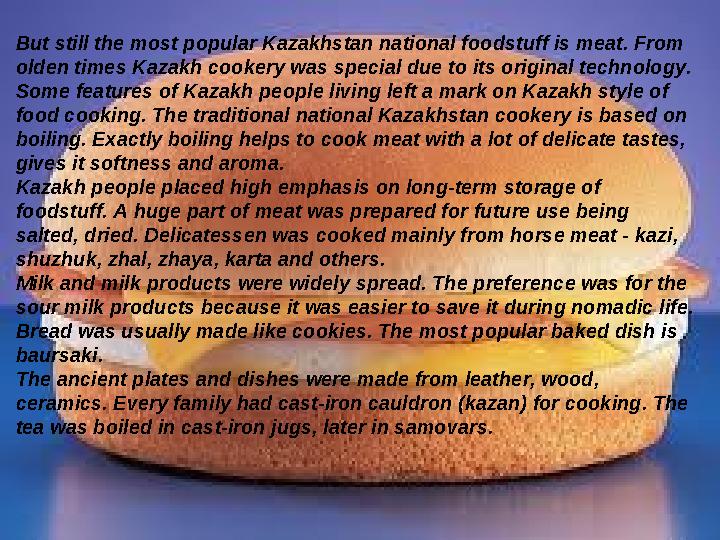
#15 слайд
But still the most popular Kazakhstan national foodstuff is meat. From
olden times Kazakh cookery was special due to its original technology.
Some features of Kazakh people living left a mark on Kazakh style of
food cooking. The traditional national Kazakhstan cookery is based on
boiling. Exactly boiling helps to cook meat with a lot of delicate tastes,
gives it softness and aroma.
Kazakh people placed high emphasis on long-term storage of
foodstuff. A huge part of meat was prepared for future use being
salted, dried. Delicatessen was cooked mainly from horse meat - kazi,
shuzhuk, zhal, zhaya, karta and others.
Milk and milk products were widely spread. The preference was for the
sour milk products because it was easier to save it during nomadic life.
Bread was usually made like cookies. The most popular baked dish is
baursaki.
The ancient plates and dishes were made from leather, wood,
ceramics. Every family had cast-iron cauldron (kazan) for cooking. The
tea was boiled in cast-iron jugs, later in samovars.
15 слайд
But still the most popular Kazakhstan national foodstuff is meat. From olden times Kazakh cookery was special due to its original technology. Some features of Kazakh people living left a mark on Kazakh style of food cooking. The traditional national Kazakhstan cookery is based on boiling. Exactly boiling helps to cook meat with a lot of delicate tastes, gives it softness and aroma. Kazakh people placed high emphasis on long-term storage of foodstuff. A huge part of meat was prepared for future use being salted, dried. Delicatessen was cooked mainly from horse meat - kazi, shuzhuk, zhal, zhaya, karta and others. Milk and milk products were widely spread. The preference was for the sour milk products because it was easier to save it during nomadic life. Bread was usually made like cookies. The most popular baked dish is baursaki. The ancient plates and dishes were made from leather, wood, ceramics. Every family had cast-iron cauldron (kazan) for cooking. The tea was boiled in cast-iron jugs, later in samovars.
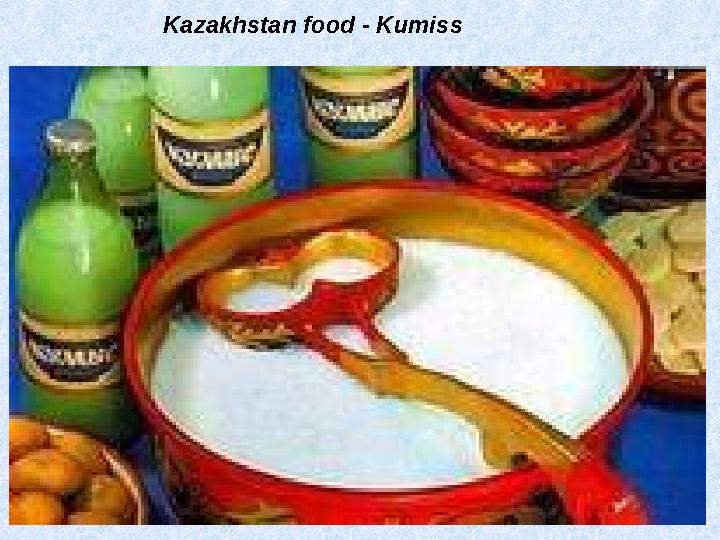
#16 слайд
Kazakhstan food - Kumiss
16 слайд
Kazakhstan food - Kumiss
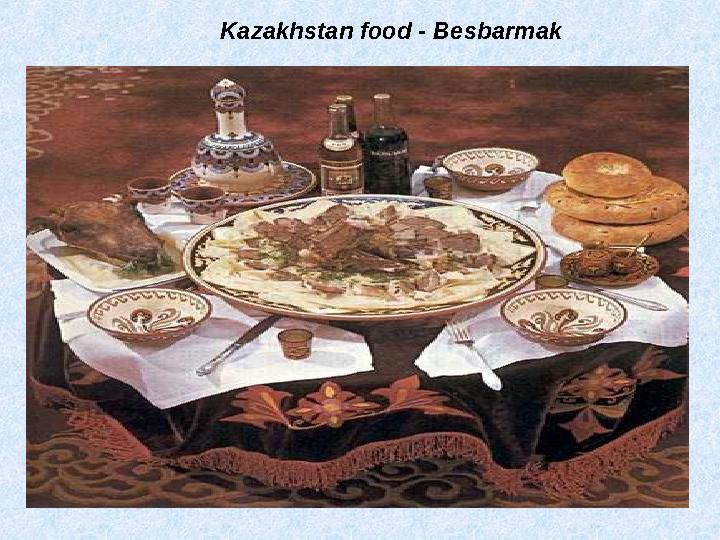
#17 слайд
Kazakhstan food - Besbarmak
17 слайд
Kazakhstan food - Besbarmak
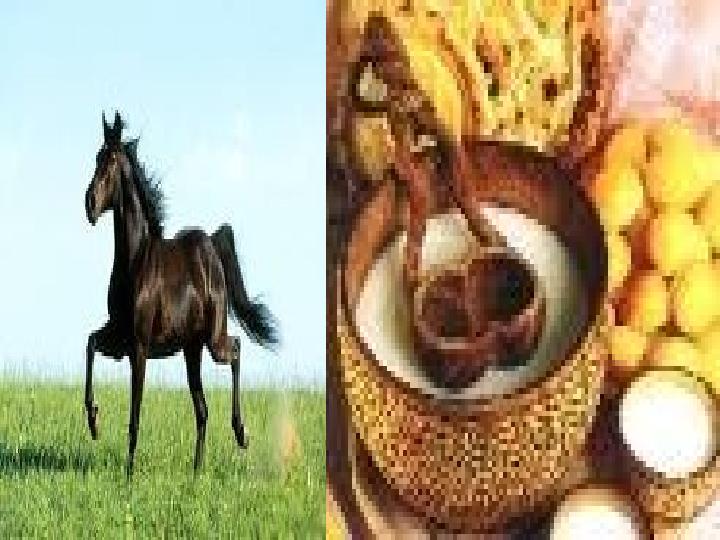
#18 слайд
18 слайд
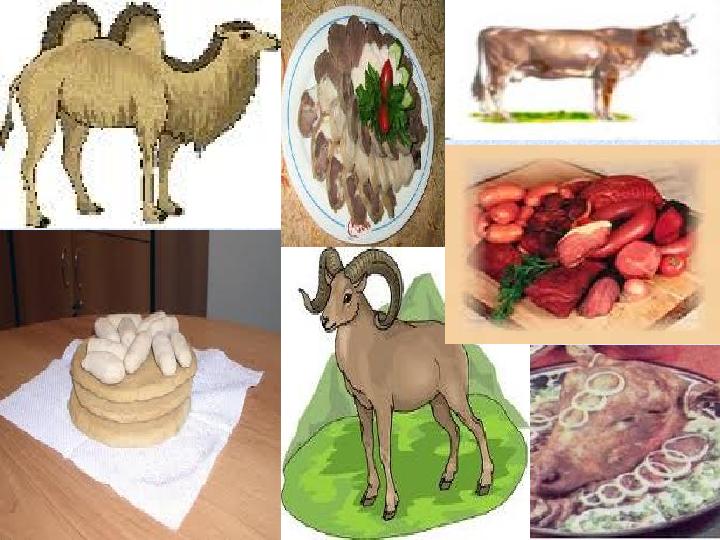
#19 слайд
19 слайд
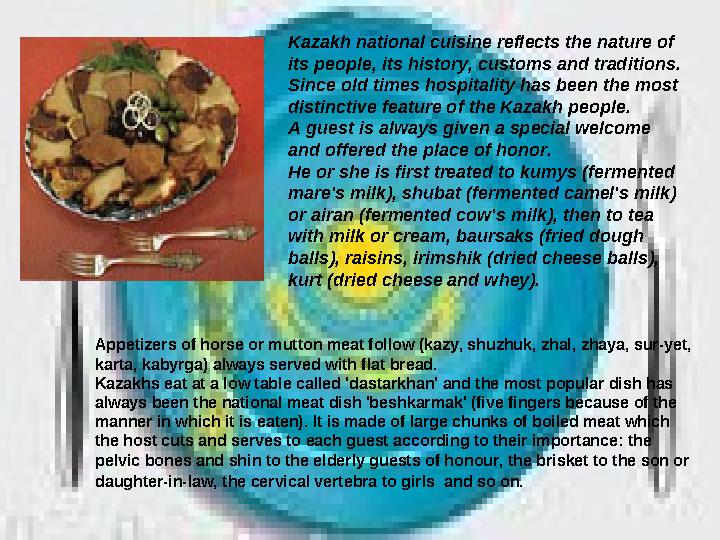
#20 слайд
Kazakh national cuisine reflects the nature of
its people, its history, customs and traditions.
Since old times hospitality has been the most
distinctive feature of the Kazakh people.
A guest is always given a special welcome
and offered the place of honor.
He or she is first treated to kumys (fermented
mare's milk), shubat (fermented camel's milk)
or airan (fermented cow's milk), then to tea
with milk or cream, baursaks (fried dough
balls), raisins, irimshik (dried cheese balls),
kurt (dried cheese and whey).
Appetizers of horse or mutton meat follow (kazy, shuzhuk, zhal, zhaya, sur-yet,
karta, kabyrga) always served with flat bread.
Kazakhs eat at a low table called 'dastarkhan' and the most popular dish has
always been the national meat dish 'beshkarmak' (five fingers because of the
manner in which it is eaten). It is made of large chunks of boiled meat which
the host cuts and serves to each guest according to their importance: the
pelvic bones and shin to the elderly guests of honour, the brisket to the son or
daughter-in-law, the cervical vertebra to girls and so on.
20 слайд
Kazakh national cuisine reflects the nature of its people, its history, customs and traditions. Since old times hospitality has been the most distinctive feature of the Kazakh people. A guest is always given a special welcome and offered the place of honor. He or she is first treated to kumys (fermented mare's milk), shubat (fermented camel's milk) or airan (fermented cow's milk), then to tea with milk or cream, baursaks (fried dough balls), raisins, irimshik (dried cheese balls), kurt (dried cheese and whey). Appetizers of horse or mutton meat follow (kazy, shuzhuk, zhal, zhaya, sur-yet, karta, kabyrga) always served with flat bread. Kazakhs eat at a low table called 'dastarkhan' and the most popular dish has always been the national meat dish 'beshkarmak' (five fingers because of the manner in which it is eaten). It is made of large chunks of boiled meat which the host cuts and serves to each guest according to their importance: the pelvic bones and shin to the elderly guests of honour, the brisket to the son or daughter-in-law, the cervical vertebra to girls and so on.
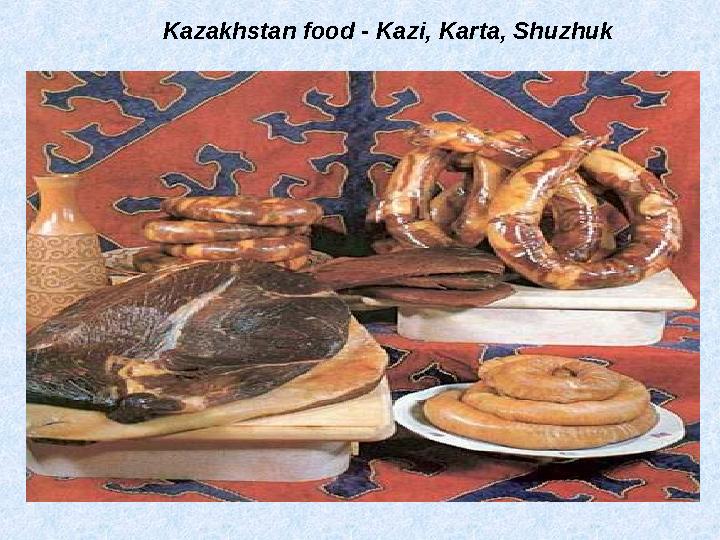
#21 слайд
Kazakhstan food - Kazi, Karta, Shuzhuk
21 слайд
Kazakhstan food - Kazi, Karta, Shuzhuk
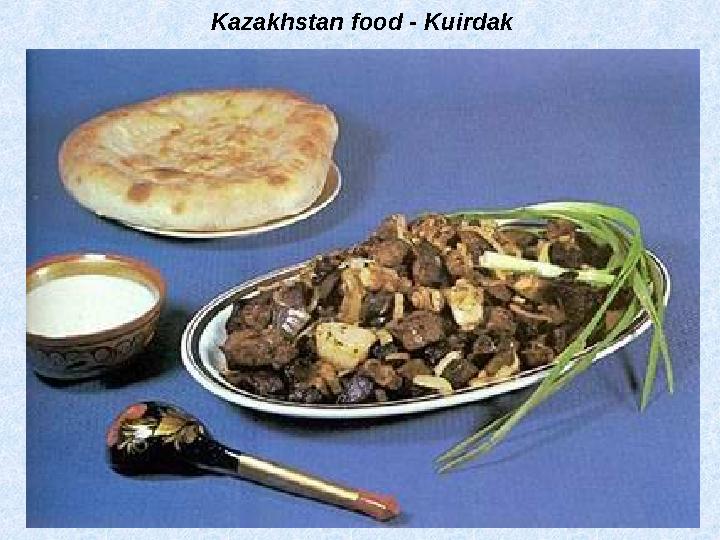
#22 слайд
Kazakhstan food - Kuirdak
22 слайд
Kazakhstan food - Kuirdak
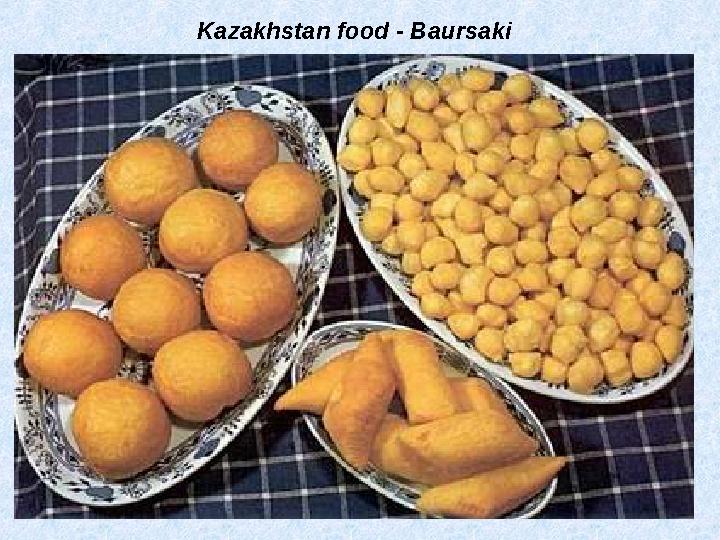
#23 слайд
Kazakhstan food - Baursaki
23 слайд
Kazakhstan food - Baursaki
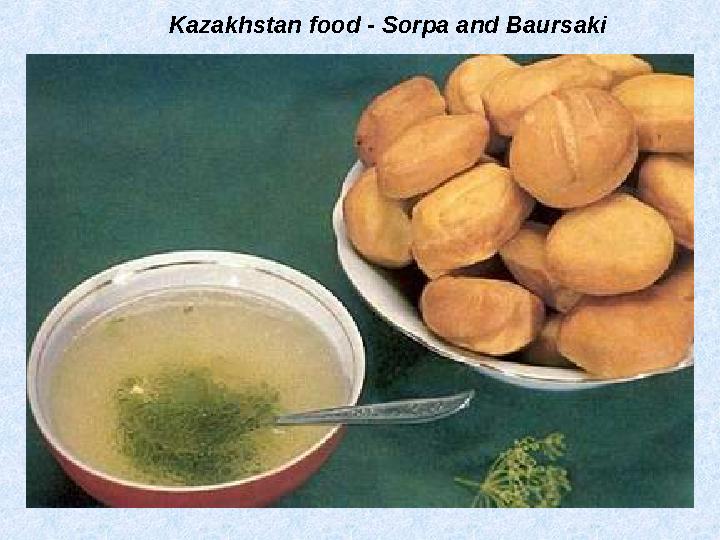
#24 слайд
Kazakhstan food - Sorpa and Baursaki
24 слайд
Kazakhstan food - Sorpa and Baursaki

#25 слайд
Today Kazakh meal is something different from the old one but still
it is imbued with ancient laws of hospitability. On the contrary the
hospitability is larger then ever for now because not only Kazakhs
but people of various nations (Kazakhstan is a multinational
country) have a meal around the dastarkhan: Russians, Tatars,
Ukrainians, Uzbeks, Germans, Uigurs, Koreans and more. All these
nations made their contribution on Kazakhs cookery.
Kazakhstan cuisine includes not only traditional national
Kazakhstan dishes but the best dishes of Uzbek, Russian, Tatar,
Korean and other cookeries. That’s why Kazakh cuisine saving its
national characteristic features has some international features.
The assortment of food groceries was changed slightly. During its
long history Kazakhstan people gathered a huge experience in
cooking dishes from meat and milk. And modern times filled it with a
large range of vegetables, fruit, fish, sea stuff, baked, flour dishes
and confectionery.
25 слайд
Today Kazakh meal is something different from the old one but still it is imbued with ancient laws of hospitability. On the contrary the hospitability is larger then ever for now because not only Kazakhs but people of various nations (Kazakhstan is a multinational country) have a meal around the dastarkhan: Russians, Tatars, Ukrainians, Uzbeks, Germans, Uigurs, Koreans and more. All these nations made their contribution on Kazakhs cookery. Kazakhstan cuisine includes not only traditional national Kazakhstan dishes but the best dishes of Uzbek, Russian, Tatar, Korean and other cookeries. That’s why Kazakh cuisine saving its national characteristic features has some international features. The assortment of food groceries was changed slightly. During its long history Kazakhstan people gathered a huge experience in cooking dishes from meat and milk. And modern times filled it with a large range of vegetables, fruit, fish, sea stuff, baked, flour dishes and confectionery.
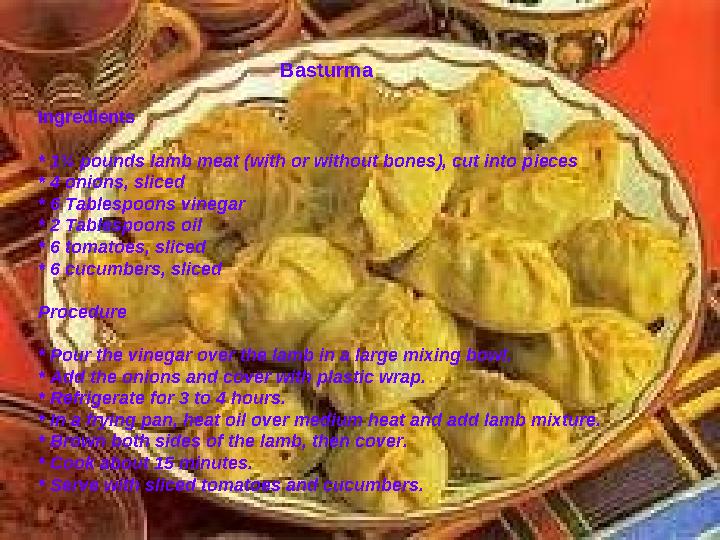
#26 слайд
Basturma
Ingredients
* 1¾ pounds lamb meat (with or without bones), cut into pieces
* 4 onions, sliced
* 6 Tablespoons vinegar
* 2 Tablespoons oil
* 6 tomatoes, sliced
* 6 cucumbers, sliced
Procedure
* Pour the vinegar over the lamb in a large mixing bowl.
* Add the onions and cover with plastic wrap.
* Refrigerate for 3 to 4 hours.
* In a frying pan, heat oil over medium heat and add lamb mixture.
* Brown both sides of the lamb, then cover.
* Cook about 15 minutes.
* Serve with sliced tomatoes and cucumbers.
26 слайд
Basturma Ingredients * 1¾ pounds lamb meat (with or without bones), cut into pieces * 4 onions, sliced * 6 Tablespoons vinegar * 2 Tablespoons oil * 6 tomatoes, sliced * 6 cucumbers, sliced Procedure * Pour the vinegar over the lamb in a large mixing bowl. * Add the onions and cover with plastic wrap. * Refrigerate for 3 to 4 hours. * In a frying pan, heat oil over medium heat and add lamb mixture. * Brown both sides of the lamb, then cover. * Cook about 15 minutes. * Serve with sliced tomatoes and cucumbers.

#27 слайд
Native fruits are grown in mewäzar bagh (orchards) and include orik
(apricots), shäftali (peaches), qawun (melons), apples, and uzum (grapes).
Plov (rice pilaf) is a side dish usually made with rice, dried apricots, dates,
prunes, or Kazakh apples.
Plov (Rice Pilaf)
Garlic, dates, almonds, apricots, and prunes (clockwise from top) are
added to rice and ground meat (usually lamb) to make plov, or Kazakh rice
pilaf.
EPD Photos
Ingredients
* 1½ cups cooked rice
* ⅓ cup slivered almonds
* 2 garlic cloves, minced
* ½ cup dates, pitted and chopped
* ⅓ cup prunes, pitted and chopped
* 3 dried apricots, chopped
* 1 Tablespoon salt
* ½–1 pound ground lamb
* 1 teaspoon vegetable oil
* 1 onion, finely chopped
27 слайд
Native fruits are grown in mewäzar bagh (orchards) and include orik (apricots), shäftali (peaches), qawun (melons), apples, and uzum (grapes). Plov (rice pilaf) is a side dish usually made with rice, dried apricots, dates, prunes, or Kazakh apples. Plov (Rice Pilaf) Garlic, dates, almonds, apricots, and prunes (clockwise from top) are added to rice and ground meat (usually lamb) to make plov, or Kazakh rice pilaf. EPD Photos Ingredients * 1½ cups cooked rice * ⅓ cup slivered almonds * 2 garlic cloves, minced * ½ cup dates, pitted and chopped * ⅓ cup prunes, pitted and chopped * 3 dried apricots, chopped * 1 Tablespoon salt * ½–1 pound ground lamb * 1 teaspoon vegetable oil * 1 onion, finely chopped
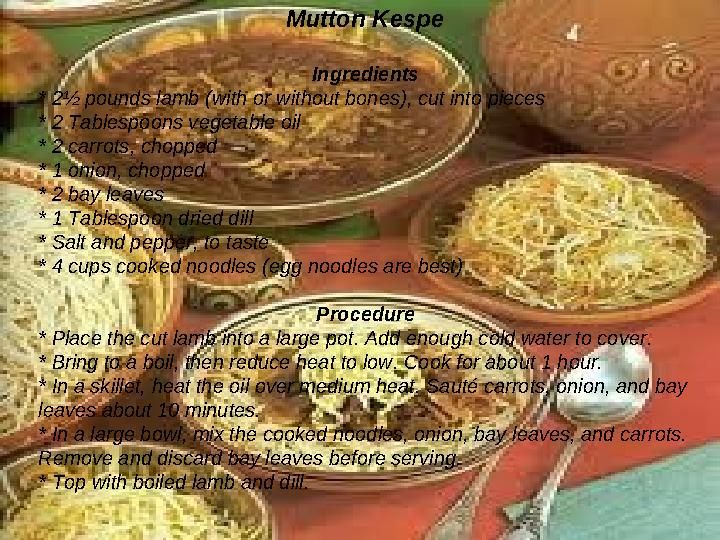
#28 слайд
Mutton Kespe
Ingredients
* 2½ pounds lamb (with or without bones), cut into pieces
* 2 Tablespoons vegetable oil
* 2 carrots, chopped
* 1 onion, chopped
* 2 bay leaves
* 1 Tablespoon dried dill
* Salt and pepper, to taste
* 4 cups cooked noodles (egg noodles are best)
Procedure
* Place the cut lamb into a large pot. Add enough cold water to cover.
* Bring to a boil, then reduce heat to low. Cook for about 1 hour.
* In a skillet, heat the oil over medium heat. Sauté carrots, onion, and bay
leaves about 10 minutes.
* In a large bowl, mix the cooked noodles, onion, bay leaves, and carrots.
Remove and discard bay leaves before serving.
* Top with boiled lamb and dill.
28 слайд
Mutton Kespe Ingredients * 2½ pounds lamb (with or without bones), cut into pieces * 2 Tablespoons vegetable oil * 2 carrots, chopped * 1 onion, chopped * 2 bay leaves * 1 Tablespoon dried dill * Salt and pepper, to taste * 4 cups cooked noodles (egg noodles are best) Procedure * Place the cut lamb into a large pot. Add enough cold water to cover. * Bring to a boil, then reduce heat to low. Cook for about 1 hour. * In a skillet, heat the oil over medium heat. Sauté carrots, onion, and bay leaves about 10 minutes. * In a large bowl, mix the cooked noodles, onion, bay leaves, and carrots. Remove and discard bay leaves before serving. * Top with boiled lamb and dill.
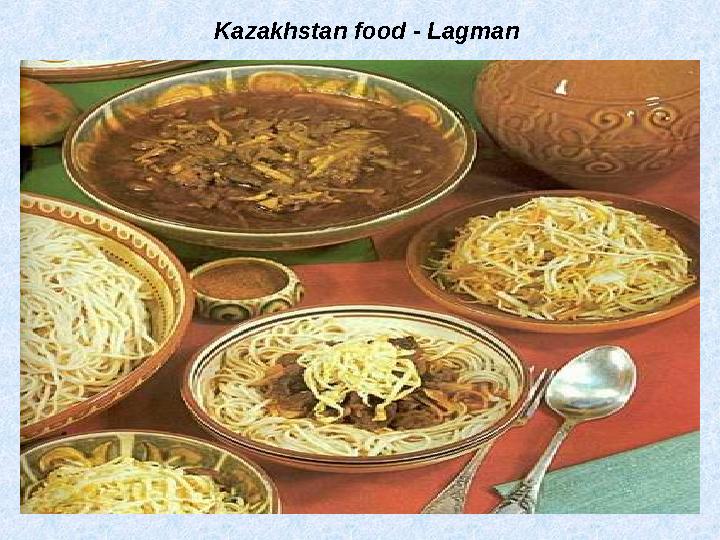
#29 слайд
Kazakhstan food - Lagman
29 слайд
Kazakhstan food - Lagman

#30 слайд
Kazakhstan food - Palau
30 слайд
Kazakhstan food - Palau

#31 слайд
Kazakhstan food - Manti
31 слайд
Kazakhstan food - Manti
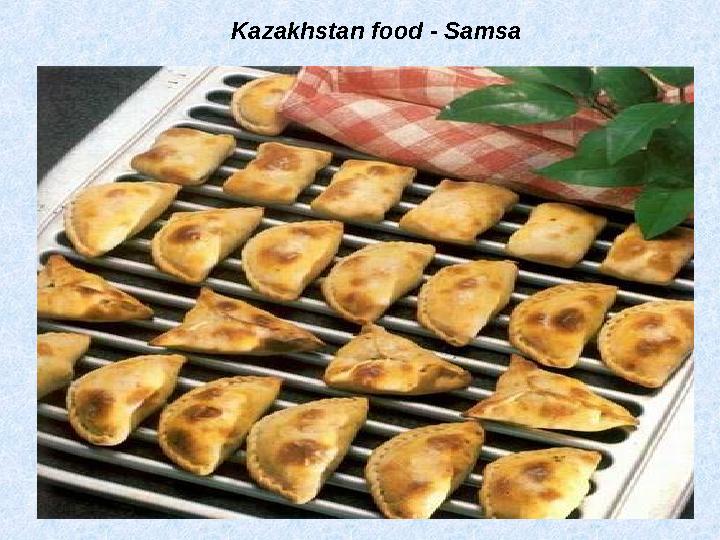
#32 слайд
Kazakhstan food - Samsa
32 слайд
Kazakhstan food - Samsa
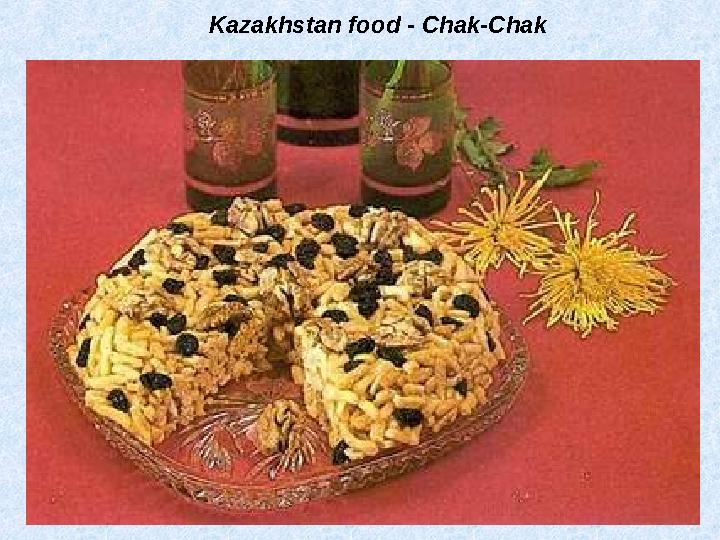
#33 слайд
Kazakhstan food - Chak-Chak
33 слайд
Kazakhstan food - Chak-Chak
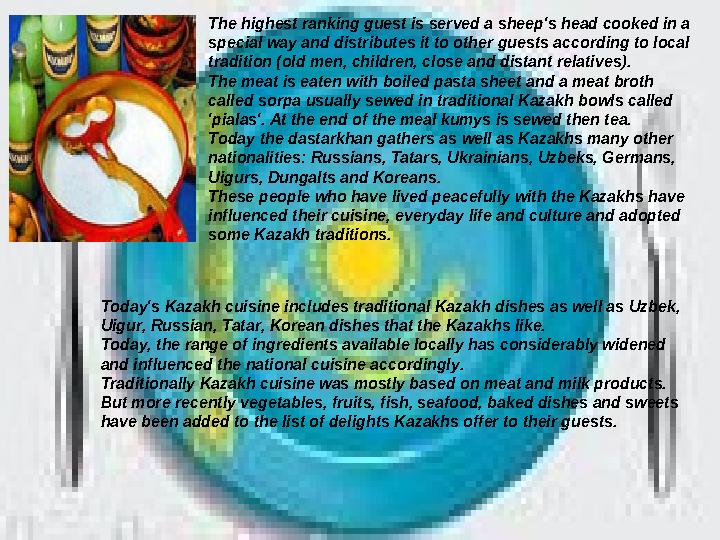
#34 слайд
The highest ranking guest is served a sheep's head cooked in a
special way and distributes it to other guests according to local
tradition (old men, children, close and distant relatives).
The meat is eaten with boiled pasta sheet and a meat broth
called sorpa usually sewed in traditional Kazakh bowls called
'pialas'. At the end of the meal kumys is sewed then tea.
Today the dastarkhan gathers as well as Kazakhs many other
nationalities: Russians, Tatars, Ukrainians, Uzbeks, Germans,
Uigurs, Dungalts and Koreans.
These people who have lived peacefully with the Kazakhs have
influenced their cuisine, everyday life and culture and adopted
some Kazakh traditions.
Today's Kazakh cuisine includes traditional Kazakh dishes as well as Uzbek,
Uigur, Russian, Tatar, Korean dishes that the Kazakhs like.
Today, the range of ingredients available locally has considerably widened
and influenced the national cuisine accordingly.
Traditionally Kazakh cuisine was mostly based on meat and milk products.
But more recently vegetables, fruits, fish, seafood, baked dishes and sweets
have been added to the list of delights Kazakhs offer to their guests.
34 слайд
The highest ranking guest is served a sheep's head cooked in a special way and distributes it to other guests according to local tradition (old men, children, close and distant relatives). The meat is eaten with boiled pasta sheet and a meat broth called sorpa usually sewed in traditional Kazakh bowls called 'pialas'. At the end of the meal kumys is sewed then tea. Today the dastarkhan gathers as well as Kazakhs many other nationalities: Russians, Tatars, Ukrainians, Uzbeks, Germans, Uigurs, Dungalts and Koreans. These people who have lived peacefully with the Kazakhs have influenced their cuisine, everyday life and culture and adopted some Kazakh traditions. Today's Kazakh cuisine includes traditional Kazakh dishes as well as Uzbek, Uigur, Russian, Tatar, Korean dishes that the Kazakhs like. Today, the range of ingredients available locally has considerably widened and influenced the national cuisine accordingly. Traditionally Kazakh cuisine was mostly based on meat and milk products. But more recently vegetables, fruits, fish, seafood, baked dishes and sweets have been added to the list of delights Kazakhs offer to their guests.
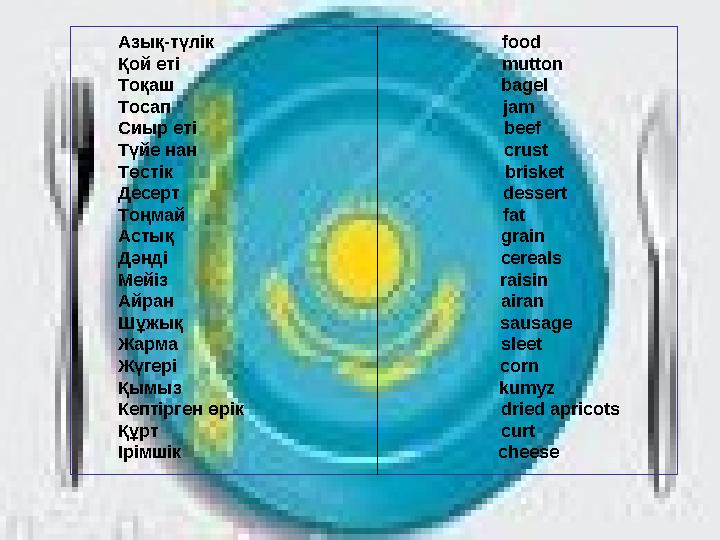
#35 слайд
Азық-түлік food
Қой еті mutton
Тоқаш bagel
Тосап jam
Сиыр еті beef
Түйе нан crust
Төстік brisket
Десерт dessert
Тоңмай fat
Астық grain
Дәнді cereals
Мейіз raisin
Айран airan
Шұжық sausage
Жарма sleet
Жүгері corn
Қымыз kumyz
Кептірген өрік dried apricots
Құрт curt
Ірімшік cheese
35 слайд
Азық-түлік food Қой еті mutton Тоқаш bagel Тосап jam Сиыр еті beef Түйе нан crust Төстік brisket Десерт dessert Тоңмай fat Астық grain Дәнді cereals Мейіз raisin Айран airan Шұжық sausage Жарма sleet Жүгері corn Қымыз kumyz Кептірген өрік dried apricots Құрт curt Ірімшік cheese
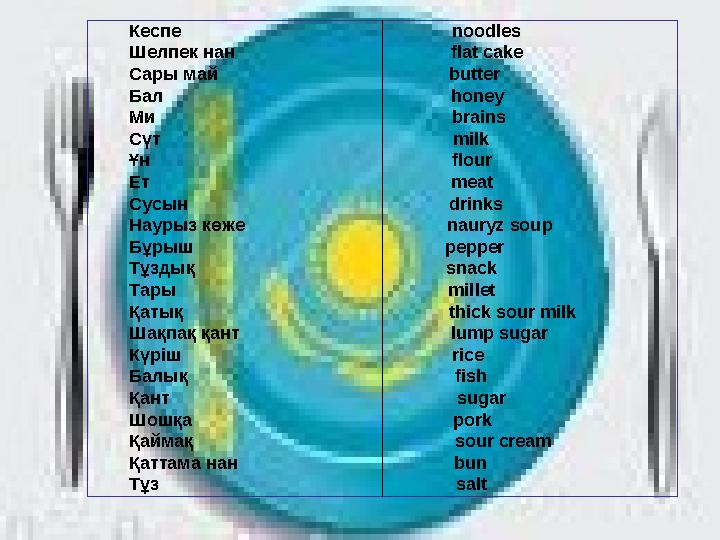
#36 слайд
Кеспе noodles
Шелпек нан flat cake
Сары май butter
Бал honey
Ми brains
Сүт milk
Ұн flour
Ет meat
Сусын drinks
Наурыз көже nauryz soup
Бұрыш pepper
Тұздық snack
Тары millet
Қатық thick sour milk
Шақпақ қант lump sugar
Күріш rice
Балық fish
Қант sugar
Шошқа pork
Қаймақ sour cream
Қаттама нан bun
Тұз salt
36 слайд
Кеспе noodles Шелпек нан flat cake Сары май butter Бал honey Ми brains Сүт milk Ұн flour Ет meat Сусын drinks Наурыз көже nauryz soup Бұрыш pepper Тұздық snack Тары millet Қатық thick sour milk Шақпақ қант lump sugar Күріш rice Балық fish Қант sugar Шошқа pork Қаймақ sour cream Қаттама нан bun Тұз salt

#37 слайд
Бұзау еті veal
Қамыр pastry
Торт cake
Тартылған ет stuffing
Бадана kidney beans
Нан bread
Шұбат shubat
Шай tea
Арпа barley
Жұмыртқа egg
Бесбармақ bescbarmak
Құймақ pancakes
Сорпа broth
Қуырдақ roast meat
Ботқа porridge
Таңертең ас breakfast
Жеңіл тамақ hors d’oevres
Түскі ас dinner
Самса pasty
Палау pilaw
Салат salad
Кауап barbecue
Supper кешкі ас
37 слайд
Бұзау еті veal Қамыр pastry Торт cake Тартылған ет stuffing Бадана kidney beans Нан bread Шұбат shubat Шай tea Арпа barley Жұмыртқа egg Бесбармақ bescbarmak Құймақ pancakes Сорпа broth Қуырдақ roast meat Ботқа porridge Таңертең ас breakfast Жеңіл тамақ hors d’oevres Түскі ас dinner Самса pasty Палау pilaw Салат salad Кауап barbecue Supper кешкі ас
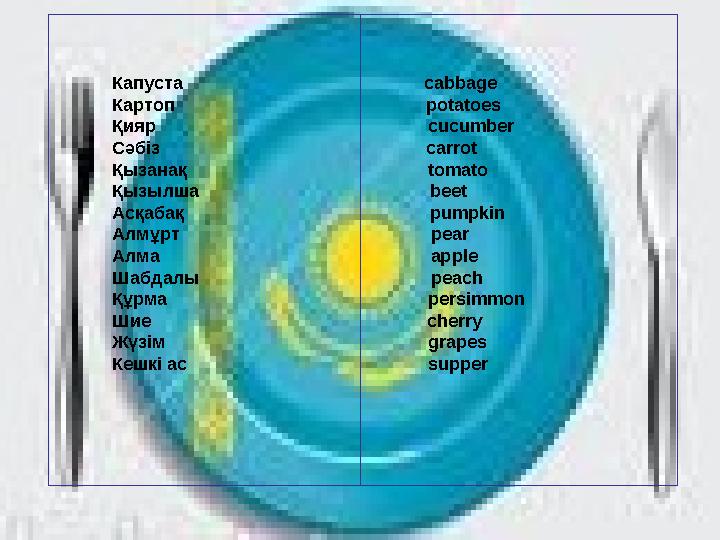
#38 слайд
Капуста cabbage
Картоп potatoes
Қияр cucumber
Сәбіз carrot
Қызанақ tomato
Қызылша beet
Асқабақ pumpkin
Алмұрт pear
Алма apple
Шабдалы peach
Құрма persimmon
Шие cherry
Жүзім grapes
Кешкі ас supper
38 слайд
Капуста cabbage Картоп potatoes Қияр cucumber Сәбіз carrot Қызанақ tomato Қызылша beet Асқабақ pumpkin Алмұрт pear Алма apple Шабдалы peach Құрма persimmon Шие cherry Жүзім grapes Кешкі ас supper

#39 слайд
Traditionally Kazakh food
39 слайд
Traditionally Kazakh food

#40 слайд
D
R
I
N
K
S
40 слайд
D R I N K S

#41 слайд
Thanks for your
attention!
41 слайд
Thanks for your attention!

шағым қалдыра аласыз
















